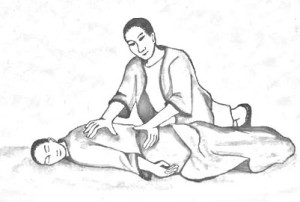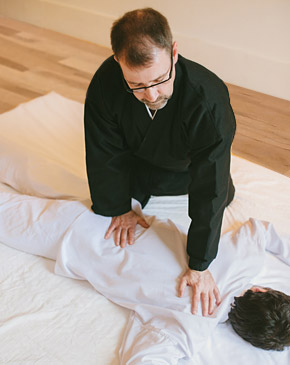Shiatsu
“He who works with his hands is a laborer. He who works with his hands and his head is a craftsman. He who works with his hands and his head and his heart is an artist.”
Saint Francis of Assisi
Between tradition and modernity
Shiatsu is a living and constantly evolving art. Like a cherry tree, its roots are strong and deep and allow it to keep growing and transforming. To this day, all over the world, new generations of practitioners contribute to the growth and ennoblement of this ancient art from Asia.
A bit of history
 Like many age-old tradition, shiatsu’s origins are lost to time immemorial. It’s possible it came from India, China or elsewhere, but it is its passage in Japan that made it the art it is today. Over time, shiatsu found its place from East to West, from North to South, adapting to its environment and its era and getting enriched over time.
Like many age-old tradition, shiatsu’s origins are lost to time immemorial. It’s possible it came from India, China or elsewhere, but it is its passage in Japan that made it the art it is today. Over time, shiatsu found its place from East to West, from North to South, adapting to its environment and its era and getting enriched over time.
At the beginning of the 20th century, it appears in the West, namely thanks to the teachings of Namikoshi and his former student, Masunaga. Shiatsu then split for the first time in modern history, when Masunaga departed from Namikoshi’s practice to develop a shiatsu based on the meridians and the pursuit of physical, psychological and emotional equilibrium according to the oriental model.
More recently, new offshoots have grown. Students of Masunaga took his method and reflections even further, each in their own way, namely:
- Sensei Wataru Ohashi (United States)
- Sensei Pauline Sasaki (United States)
- Sensei Tetsuro Saito (Canada)
- Sensei Kazunori Sasaki (France)
Shiatsu : the path of balance
Beyond the colors specific to each era and various schools, two elements transcend all forms of shiatsu: the pursuit of equilibrium and the constant and attentive presence of the therapist throughout the consultation. That said, shiatsu is also characterized by the use of a number of extremely precious tools, such as:
- the theory of Yin and Yang;
- the theory of the five elements;
- Bo shin (observing), Setsu shin (palpation), Mon shin (questioning) and Bun shin (listening and observing globally);
- the reading of the hara (Kyo/Jitsu);
- the classical meridians and the meridians of Masunaga;
- traditional katas.
With these tools, the shiatsu therapist is able to evaluate the state of their client and to build an intervention strategy that is both complete and precise. Its objective is to meet the client’s specific needs and to help them reach a physical, psychological and emotional equilibrium. Furthermore, every person being different and constantly evolving, every shiatsu session will be as well.
Peripheral reading of meridians
The Peripheral reading of meridians (PRM) is a rich and accessible tool developed by Sensei Stéphane Vien. This unique and revolutionary approach offers a new depth to the practice of shiatsu.
PRM can be used on its own or in conjunction with the reading of the hara, and helps the practitioner to:
- complement and enhance the reading of the hara;
- have a quicker access to energy imbalances;
- determine the order of interventions on the meridians;
- make treatments more precise, deep and homogenous;
- get a better understanding of the clients and their health condition;
- meet the clients’ needs more quickly.
“To summarize, I would say that the reading of the hara give me the nature of the imbalance, whereas the PRM tells me the intervention strategy I should follow. For example, the reading of the hara of a client suffering from sciatica once had little to nothing to do with his condition. On the other hand, PRM then clearly indicated which meridians to work on and in what order.”
Sensei Stéphane Vien
Benefits of shiatsu
Shiatsu is both a preventative and therapeutic approach that delves into health problems’ causes rather than their symptoms. Receiving a shiatsu regularly or occasionally helps the client to:
- enhance their muscle tissues flexibility
- relieve any muscular and articular pain
- overcome insomnia
- reduce the symptoms of menopause
- rebalance their nervous system
- reduce headaches
- regain energy
- cure fatigue
- enhance their digestion (e.g. relief of constipation and bloating)
- stimulate their blood and lymph circulation
- boost their concentration
- calm themselves and manage their emotions
- reduce menstrual pain
- go through hard times (e.g. separation, grief, moving, exams)
Also, shiatsu is an excellent complement to follow-ups in physiotherapy, chiropraxis, osteopathy and even psychotherapy.
Learn more
Websites
- http://www.ohashiatsu.org/us/
Sensei Wataru Ohashi’s school’s website - http://www.ffst.fr
Fédération Française de shiatsu traditionnel website - http://www.shiatsu-arts-culture.com/
Shiatsu Arts Culture website
Books and articles
- Wataru Ohashi, Beyond Shiatsu: Ohashis Bodywork Method.
- Carola Beresford-Cooke, Shiatsu theory and practice.
- Shizuto Masunaga, Zen shiatsu: How to Harmonize Yin and Yang for Better Health.
- Isabelle Laading, Shiatsu : Voie d’équilibre.
- Jeremy Ross, Zang Fu: The Organ Systems of Traditional Chinese Medicine.
- Marie-Michèle Lapointe-Cloutier, Lecture périphérique des méridiens : Percevoir l’énergie autrement. Entrevue avec Stéphane Vien.


